Looking to register your car in California? This comprehensive guide will walk you through the process step-by-step. First, understand the state’s car registration requirements for vehicles owned within or imported into California. Next, gather essential documents for a seamless vin verification process, including proof of ownership and identification. After passing the VIN check, complete the registration online or visit a DMV office. Finally, pay fees and obtain your license plate to legally hit the road.
- Understand California Car Registration Requirements
- Gather Necessary Documents for VIN Verification
- Perform Vehicle Identification Number (VIN) Check
- Complete Online Registration or Visit DMV
- Pay Registration Fees and Obtain License Plate
Understand California Car Registration Requirements

Before registering your car in California, it’s crucial to understand the state’s specific requirements. One key aspect is ensuring accurate and up-to-date vehicle identification number (VIN) information. Every car sold in California must undergo a VIN verification process, which confirms the vehicle’s identity and history. This includes checking for any outstanding recalls or issues reported by manufacturers.
A critical step in this process involves obtaining a valid registration from the original owner or dealer. Additionally, you’ll need to present valid identification documents and proof of insurance. For convenience, many residents opt for mobile VIN verification services, allowing them to complete the initial inspection from the comfort of their homes. Alternatively, you can visit a designated California Department of Motor Vehicles (DMV) office for manual vin inspection.
Gather Necessary Documents for VIN Verification

Before you begin the registration process, it’s crucial to gather all the essential documents for VIN (Vehicle Identification Number) verification. This includes your vehicle’s registration certificate from the previous state, a valid driver’s license, and proof of insurance. Additionally, you’ll need the title or lease agreement if applicable. For a hassle-free experience, many California DMV locations now accept mobile VIN verifiers, which can help streamline this step by quickly validating your car’s history and details.
Having these documents ready ensures a smoother process when registering your vehicle in California. Remember that accurate and up-to-date information is key, so double-check all the details before proceeding to avoid delays or issues down the line.
Perform Vehicle Identification Number (VIN) Check

Before registering your car in California, it’s crucial to perform a Vehicle Identification Number (VIN) check. This verification process ensures that the vehicle matches its associated documentation and helps prevent fraud. You can conduct this vin inspection by using a reliable mobile vin verifier or even requesting a professional vin inspection service.
A simple online search for “mobile vin inspection” or “vin verification near me” will yield numerous options, allowing you to conveniently schedule an appointment at your nearest location. Alternatively, some car registration services also offer this step as part of their comprehensive vehicle preparation process, ensuring that everything is in order before submitting your application.
Complete Online Registration or Visit DMV

You have two options for registering your car in California: complete the process online or visit a DMV office in person. Both methods require preparation and specific documentation, but they differ in convenience and time commitment. If you’re comfortable with technology and prefer a more efficient approach, consider registering your vehicle online through the California Department of Motor Vehicles (DMV) website. This option allows for real-time verification of important details like your identity and vehicle history, including a crucial step known as VIN verification. A valid Vehicle Identification Number (VIN) inspection is essential to ensure that your car matches the information on record.
Alternatively, if you prefer face-to-face interaction or have concerns about the online process, visiting a DMV office remains a reliable method. There, you’ll need to bring several documents, including proof of ownership and identification. A mobile VIN verifier can be particularly useful here, as it allows for an on-site inspection of your vehicle’s VIN, ensuring accuracy without adding another trip to your to-do list.
Pay Registration Fees and Obtain License Plate

After completing the registration application process, the next step involves paying the required fees for car registration in California. These fees cover various costs associated with maintaining vehicle records and issuing license plates. The amount due will depend on factors such as your vehicle’s age, type, and emissions status. You can typically pay these fees online, by mail, or in person at a DMV office. Once you’ve settled the charges, it’s time to obtain your vehicle’s license plate. In California, these plates display both a unique identifier and the vehicle’s Vehicle Identification Number (VIN).
For added convenience and speed, consider utilizing mobile VIN verification services. These options allow for a quick and easy inspection of your vehicle’s history right from your smartphone. This can help ensure that your car meets all the necessary requirements before registration, streamlining the overall process.
Registering a car in California is a straightforward process that requires understanding specific requirements and gathering essential documents. By performing a Vehicle Identification Number (VIN) check, completing either an online registration or a visit to the DMV, and paying relevant fees, you can ensure your vehicle’s legal status. Remember, accurate VIN verification is crucial for a smooth registration experience in the Golden State.
